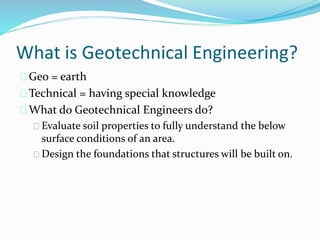The Basic Principles Of Geotheta
The Basic Principles Of Geotheta
Blog Article
Geotheta Fundamentals Explained
Table of ContentsSome Ideas on Geotheta You Should KnowGeotheta Things To Know Before You Get ThisThe Greatest Guide To GeothetaGeotheta for Beginners
They collaborate with civil engineers, structural designers, designers, and other professionals to integrate geotechnical considerations right into the total job style and building and construction procedure. This needs efficient team effort, sychronisation, and communication to make sure that the geotechnical elements line up with the job objectives and meet governing demands.Mining & Materials Engineering: Concepts of boring, infiltration rates, and elements affecting the option of boring approach. Blasting techniques in surface area and below ground operations. Mechanical and constant strategies to fragmentation, including longwall shearing and fullface boring.
Integrated evaluation of fragmentation and comminution procedures. Offered by: Mining & Products Engineering.
The Basic Principles Of Geotheta
Bachelor's level programs in civil, geotechnical, geological, and environmental design usually last four years and include general education and learning training courses in English, social science, and the humanities, in addition to courses in sophisticated maths, architectural geology, and liquid mineralogy. (https://allmyfaves.com/geotheta?tab=Geotheta)
Geotechnical design entails the evaluation of the soil and rock problems at a particular website, and their ramifications for the advancement of that site. As most frameworks count on the ground for assistance, it lacks shock that a comprehensive understanding of the ground conditions, and the viability of structure systems, are important to the lasting security and efficiency of the building or framework.
Specialising in the examination of geological formations and ground behavior, geotechnical engineers do scientific investigations and testing to recognize the influence these geological developments may have on the style and building and construction of structure, civil and infrastructure projects. This experience is essential for the style and building of structures, roadways, tunnels, dams, bridges, and supply of water and sewer systems.
The geotechnical group at Douglas Partners routinely consult with designers, layout engineers, developers, and builders to make referrals on design and growth propositions to make certain that the constructed frameworks are appropriately created for the ground conditions. The style of footing systems needs to consider the weight of the structure, the ability of the ground to sustain that weight with each other with motion tolerances and efficient building and construction.
Geotheta Fundamentals Explained
This job is substantially simplified by the usage of our Douglas Map geospatial system which makes this info easily easily accessible in an easy to utilize web browser user interface. A geotechnical engineer will guide the exploration of boreholes and test pits to collect dirt and other examples, and additionally examine surface functions and ground direct exposures to form a geotechnical version of the subsurface conditions.
Relying on the project kind and ground conditions encountered, laboratory screening might to name a few points evaluate strength, compressibility, reactivity and/or look these up leaks in the structure of dirt and rock examples. After this data is accumulated and looked at, the results are utilized for a geotechnical version of the website, which is usually offered as sections across the site.

A geotechnical investigation by nature can only analyze the ground conditions at the places drilled or dug deep into. Natural variations in dirt and rock problems can occur throughout a website and between examination areas. It is therefore great method that the geotechnical designer be kept throughout building and construction of the task to provide on-site verification that the ground conditions run into follow the expectations and advice offered in the geotechnical examination record.
The Definitive Guide for Geotheta
Geotechnical engineers use their comprehensive knowledge of dirt and rock to examine threat and resolve issues on diverse framework projectsGeotechnical design is a specialist branch of civil engineering which considers the behaviour of earth products and the application of dirt and rock auto mechanics. Engineer of Record. As a geotechnical engineer, you will certainly assess the physical, mechanical and chemical residential properties of dirt and rock in order to develop structures, retaining structures and earthworks
Geotechnical design is carefully linked to and overlaps with, both engineering geology and ground engineering - https://www.startus.cc/company/geotheta. It's feasible to be experts in geotechnics or help a geotechnical firm however be understood as a design rock hound or a ground designer. As a geotechnical engineer, you'll require to: construct and keep connections with customers and other specialists entailed in the site, throughout each projectmaintain safety and security criteria on site be mindful of expense ramifications when you make recommendationsstudy geological maps and aerial pictures from a series of sources and from various time periodsexamine building and construction prepares to see just how practical they are based upon your understanding of the siteinvestigate risks or geological threats for the sitesearch for eco delicate features, such as land fill beginning to establish accurate and interpretive ground modelsplan field investigationsdrill and evaluate samples of bedrock, dirt, groundwater and extra products monitor other specialists on sitesolve technical concerns as they emerge, such as unforeseen frameworks at drill sitesmonitor conditions throughout and after building and construction to see to it frameworks are steady in the brief and long termadding data accumulated on site to your preliminary researchcreating geotechnical computations, drawings, and 2 or three-dimensional computer system versions translating the datamaking referrals regarding the proposed use the website

Report this page